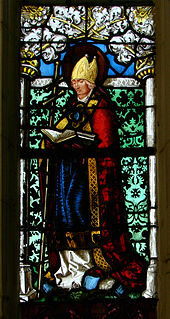Related Research Articles
The 670s decade ran from January 1, 670, to December 31, 679.
Year 677 (DCLXXVII) was a common year starting on Thursday of the Julian calendar. The denomination 677 for this year has been used since the early medieval period, when the Anno Domini calendar era became the prevalent method in Europe for naming years.

Ebroin was the Frankish mayor of the palace of Neustria on two occasions; firstly from 658 to his deposition in 673 and secondly from 675 to his death in 680 or 681. In a violent and despotic career, he strove to impose the authority of Neustria, which was under his control, over Burgundy and Austrasia.

Clovis II was King of Neustria and Burgundy, having succeeded his father Dagobert I in 639. His brother Sigebert III had been King of Austrasia since 634. He was initially under the regency of his mother Nanthild until her death in her early thirties in 642. Nanthild's death allowed Clovis to fall under the influence of the secular magnates, who reduced the royal power in their own favour; first Aega and then Erchinoald. The Burgundian mayor of the palace Flaochad used him to lure his rival, Willebad, to a battle in Autun, where Willebad was killed.

Dagobert II was the Merovingian king of the Franks ruling in Austrasia from 675 or 676 until his death. He is one of the more obscure Merovingians. He has been considered a martyr since at least the ninth century.

Autun is a subprefecture of the Saône-et-Loire department in the Bourgogne-Franche-Comté region of central-eastern France. It was founded during the Principate era of the early Roman Empire by Emperor Augustus as Augustodunum to give a Roman capital to the Gallic people Aedui, who had Bibracte as their political centre. In Roman times the city may have been home to 30,000 to 100,000 people, according to different estimates. Nowadays, the commune has a population of about 15,000.

Clovis IV was the king of the Franks from 690 or 691 until his death. If the brief reign of Clovis III (675) is ignored as a usurpation, then Clovis IV may be numbered Clovis III.
Ceraunus (Céran) was bishop of Paris. His relics are in the church of St. Genevieve, Paris; they are on the altar of St Clotilda. He is also said to have been bishop 609 to 622.

Leodegar of Poitiers was a martyred Burgundian Bishop of Autun. He was the son of Saint Sigrada and the brother of Saint Warinus.

October 1 - Eastern Orthodox liturgical calendar - October 3

Saint Philibert of Jumièges was an abbot and monastic founder, particularly associated with Jumièges Abbey.

The Roman Catholic Diocese of Langres is a Roman Catholic diocese comprising the département of Haute-Marne in France.

The Roman Catholic Diocese of Autun (–Chalon-sur-Saône–Mâcon–Cluny), more simply known as the Diocese of Autun, is a diocese of the Latin Rite of the Roman Catholic Church in France. The diocese comprises the entire Department of Saone et Loire, in the Region of Bourgogne.

Saint Leudwinus, Count of Treves founded an abbey in Mettlach. He was Archbishop of Treves and Laon. As patron saint of the Mettlach parish, his relics are carried through the town by procession at the annual Pentecost celebration. His feast day is September 23. He was the son of Saint Warinus, the paternal grandson of Saint Sigrada, and nephew of Saint Leodegarius.

Adalrich, also known as Eticho, was the Duke of Alsace, the founder of the family of the Etichonids and of the Habsburg, and an important and influential figure in the power politic of late-seventh-century Austrasia.
Saint Rachoof Autun is venerated as a Roman Catholic saint. He was a bishop of Autun, with a feast day on 25 January. A Cluniac priory, Saint-Racho-lès-Autun, under the protection of his name was established in southern Burgundy during the first flush of the Cluniac reform movement during the tenure of Odilon of Cluny (994–1049). The commune of Saint-Racho, Saône-et-Loire owes its historical origins to the monastery.

Saint Claudius of Besançon, sometimes called Claude the Thaumaturge, was a priest, monk, abbot, and bishop. A native of Franche-Comté, Claudius became a priest at Besançon and later a monk. Georges Goyau in the Catholic Encyclopedia wrote that “The Life of St. Claudius, Abbot of Condat, has been the subject of much controversy.” Anglican Henry Wace has written that "on this saint the inventors of legends have compiled a vast farrago of improbabilities."
Saint Genesius of Lyon was the 37th Archbishop of Lyon.

Saint Annemund, also known as Annemundus, Aunemundus, Ennemond and Chamond, was an archbishop of Lyon. Annemund was a councillor of Clovis II and a friend of Wilfrid of York. The year of his death is variously given as either 657 or 658.
Sigrada of Alsace was a Franco-Burgundian countess and mother of Ss. Warin, and Leodegar, and grandmother of St. Leudwinus.
References
- 1 2 Weiner, Dr. Andreas. "Holy Lutwinus Pray for Us! (Heiliger Lutwinus bitte für uns!)". www.lutwinuswerk.de. Retrieved June 28, 2012.
- 1 2 Margaret R Bunson, Matthew Bunson, Stephen Bunson (2003). Our Sunday Visitor's Encyclopedia Of Saints - Revised. Our Sunday Visitor Publishing. p. 1008. ISBN 1-931709-75-0.
- 1 2 Watkins, Basil, ed. (2002). Book of Saints (Reference) (7th ed.). A&C Black. pp. 655. ISBN 0713653000.
- ↑ "Saints & Angels: St. Warinus". Catholic Online. catholic.org. Retrieved June 28, 2012.